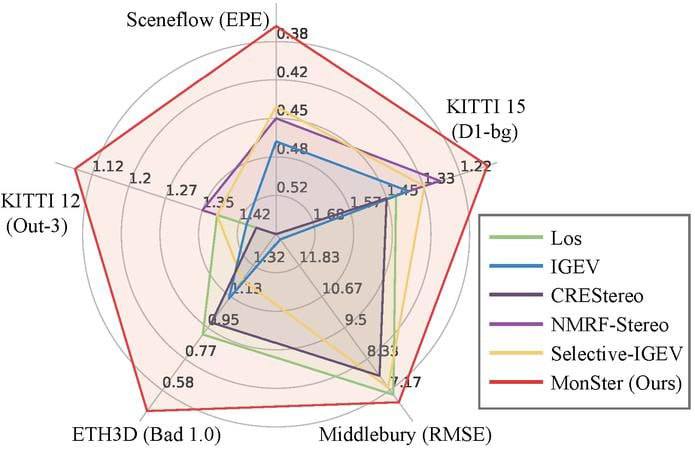tgoop.com/Machine_learn/3489
Last Update:
MonSter: Marry Monodepth to Stereo Unleashes Power
15 Jan 2025 · Junda Cheng, Longliang Liu, Gangwei Xu, Xianqi Wang, Zhaoxing Zhang, Yong Deng, Jinliang Zang, Yurui Chen, Zhipeng Cai, Xin Yang ·
Stereo matching recovers depth from image correspondences. Existing methods struggle to handle ill-posed regions with limited matching cues, such as occlusions and textureless areas. To address this, we propose MonSter, a novel method that leverages the complementary strengths of monocular depth estimation and stereo matching. MonSter integrates monocular depth and stereo matching into a dual-branch architecture to iteratively improve each other. Confidence-based guidance adaptively selects reliable stereo cues for monodepth scale-shift recovery. The refined monodepth is in turn guides stereo effectively at ill-posed regions. Such iterative mutual enhancement enables MonSter to evolve monodepth priors from coarse object-level structures to pixel-level geometry, fully unlocking the potential of stereo matching. As shown in Fig.1, MonSter ranks 1st across five most commonly used leaderboards -- SceneFlow, KITTI 2012, KITTI 2015, Middlebury, and ETH3D. Achieving up to 49.5% improvements (Bad 1.0 on ETH3D) over the previous best method. Comprehensive analysis verifies the effectiveness of MonSter in ill-posed regions. In terms of zero-shot generalization, MonSter significantly and consistently outperforms state-of-the-art across the board. The code is publicly available at: https://github.com/Junda24/MonSter.
Paper: https://arxiv.org/pdf/2501.08643v1.pdf
Code: https://github.com/junda24/monster
Datasets: KITTI - TartanAir
@Machine_learn
BY Machine learning books and papers

Share with your friend now:
tgoop.com/Machine_learn/3489
